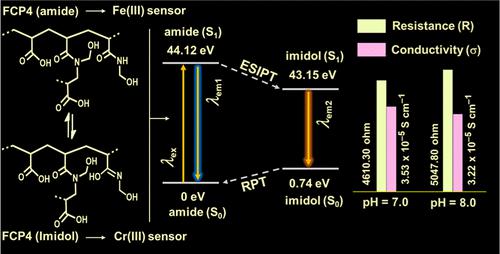当前位置:
X-MOL 学术
›
Macromolecules
›
论文详情
Our official English website, www.x-mol.net, welcomes your
feedback! (Note: you will need to create a separate account there.)
Synthesis of Intrinsically Dual-Emissive Aliphatic Conducting Polymer and ESIPT-Associated Switching of Amide-Aggregate to Imidol-Aggregate for Sensing of Cr(III) and Fe(III)
Macromolecules ( IF 5.1 ) Pub Date : 2023-11-13 , DOI: 10.1021/acs.macromol.3c00876 Madhushree Mitra 1 , MD Hussain Sanfui 2 , Shrestha Roy 2 , Mousumi Deb 2 , Chandan Roy 2 , Arnab Dutta 2 , Narendra Nath Ghosh 3 , Mostafizur Rahaman 4 , Pijush Kanti Chattopadhyay 1 , Sagar Roy 5 , Nayan Ranjan Singha 2
Macromolecules ( IF 5.1 ) Pub Date : 2023-11-13 , DOI: 10.1021/acs.macromol.3c00876 Madhushree Mitra 1 , MD Hussain Sanfui 2 , Shrestha Roy 2 , Mousumi Deb 2 , Chandan Roy 2 , Arnab Dutta 2 , Narendra Nath Ghosh 3 , Mostafizur Rahaman 4 , Pijush Kanti Chattopadhyay 1 , Sagar Roy 5 , Nayan Ranjan Singha 2
Affiliation

|
The design, synthesis, and optimization of excited-state intramolecular proton transfer (ESIPT)-associated dual-emissive aliphatic conductive polymer is one of the very challenging tasks, and has not been reported to date. Herein, aliphatic fluorescent conducting polymers (FCPs) are synthesized by polymerizing N-(monomethylol)acrylamide (MMA), acrylic acid (AA), and in situ-generated 3-N-(monomethylolacrylamido)propanoic acid (NMMAPA). Of different FCPs, the maximum population of heteroatomic nontraditional luminophores, i.e., secondary amide (−CONH), imidol (−CN(OH)), tertiary amide (−CON), and carboxylic acid (−COOH), in FCP4 is supported by the spectroscopic analyses, thermal profiles, fluorescence enhancements, and computational calculations. Thus, further investigations are made on FCP4 to explore the photophysical properties, check the suitability in dual metal ion sensing, and study the proton conductivity. The ESIPT-associated dual light emissions at 436 nm (λem1) and 573/617 nm (λem2) originate from FCP4 (amide)/FCP4 (amide)-aggregate and FCP4 (imidol)/FCP4 (imidol)-aggregate, respectively, and are supported by concentration-dependent emissions, time-correlated single photon counting studies, solvent polarity effects, and computational measurements. Regarding this, the high fluorescence quantum yields of 0.68 and 0.18 at λem1 and λem2, respectively, confirmed the ESIPT-associated strong dual emissions of FCP4. The UV spectrum within 264–300 nm, FTIR peak at 2165 cm–1, binding energies of −CN(OH)/–CN(OH) at 399.0/533.4 eV, and computational studies indicate the coexistence of FCP4 (amide)/FCP4 (amide)-aggregate and FCP4 (imidol)/FCP4 (imidol)-aggregate forms of FCP4. In FCP4, −CONH/–CN(OH)/–CON/–COOH/–CH2OH-associated dipolar and hydrogen-bonding interactions, n−π* transitions, and N-branching-associated rigidity contribute to ESIPT-associated amide–imidol phototautomerism, aggregation-enhanced emissions, dual light emissions, metal ion sensing, and conductivity. The strong coordinations of Fe(III) and Cr(III) with FCP4 (amide) and FCP4 (imidol), respectively, are supported by spectroscopic, thermal, and computational studies. The strong quenching efficiencies of Fe(III) and Cr(III) are indicated by the very low limits of detection of 0.1142 and 0.0534 ppb, respectively. The I–V and ac impedance spectroscopy data of FCP4 having 0.28 cm thickness and 1.72 cm2 area indicate high proton conductivities of 3.53 × 10–5 and 3.22 × 10–5 S cm–1 at pH = 7.0 and 8.0, respectively.
中文翻译:

本征双发射脂肪族导电聚合物的合成以及 ESIPT 相关的酰胺聚集体向亚胺醇聚集体的转换,用于 Cr(III) 和 Fe(III) 的传感
激发态分子内质子转移(ESIPT)相关的双发射脂肪族导电聚合物的设计、合成和优化是非常具有挑战性的任务之一,迄今为止尚未见报道。本文中,脂肪族荧光导电聚合物(FCP)是通过聚合N-(单羟甲基)丙烯酰胺(MMA)、丙烯酸(AA)和原位生成的3- N-(单羟甲基丙烯酰氨基)丙酸(NMMAPA)来合成的。在不同的FCP中,支持FCP4中杂原子非传统发光体的最大数量,即仲酰胺(-CONH)、亚胺醇(-CN(OH))、叔酰胺(-CON)和羧酸(-COOH)通过光谱分析、热剖面、荧光增强和计算计算。因此,对FCP4进行了进一步的研究,以探索其光物理性质,检查双金属离子传感的适用性,并研究质子电导率。436 nm (λ em1 ) 和 573/617 nm (λ em2 )处的 ESIPT 相关双光发射分别源自FCP4(酰胺)/ FCP4(酰胺)-聚集体和FCP4(亚胺醇)/ FCP4(亚胺醇)-聚集体,并得到浓度依赖性发射、时间相关的单光子计数研究、溶剂极性效应和计算测量的支持。对此,λ em1和λ em2处的高荧光量子产率分别为 0.68 和 0.18,证实了FCP4与 ESIPT 相关的强双发射。紫外光谱在264-300 nm范围内,FTIR峰在2165 cm –1处,−C N (OH)/–CN( O H)的结合能在399.0/533.4 eV,计算研究表明FCP4(酰胺)共存FCP4的/ FCP4 (酰胺)-聚集体和FCP4 (亚胺醇)/ FCP4 (亚胺醇)-聚集体形式。在FCP4中,−CONH/–CN(OH)/–CON/–COOH/–CH 2 OH 相关的偶极和氢键相互作用、n−π* 跃迁和N支化相关的刚性有助于 ESIPT 相关的酰胺–亚胺醇光互变异构、聚集增强发射、双光发射、金属离子传感和电导率。Fe(III) 和 Cr(III) 与FCP4(酰胺)和FCP4的强配位(亚胺醇)分别得到光谱、热和计算研究的支持。Fe(III) 和 Cr(III) 的强大淬灭效率分别通过极低的检测限(0.1142 和 0.0534 ppb)来体现。厚度为 0.28 cm、面积为 1.72 cm 2的FCP4的I - V和交流阻抗谱数据表明,在 pH = 7.0 和 8.0 时,其质子电导率分别为 3.53 × 10 –5和 3.22 × 10 –5 S cm –1。
更新日期:2023-11-13
中文翻译:

本征双发射脂肪族导电聚合物的合成以及 ESIPT 相关的酰胺聚集体向亚胺醇聚集体的转换,用于 Cr(III) 和 Fe(III) 的传感
激发态分子内质子转移(ESIPT)相关的双发射脂肪族导电聚合物的设计、合成和优化是非常具有挑战性的任务之一,迄今为止尚未见报道。本文中,脂肪族荧光导电聚合物(FCP)是通过聚合N-(单羟甲基)丙烯酰胺(MMA)、丙烯酸(AA)和原位生成的3- N-(单羟甲基丙烯酰氨基)丙酸(NMMAPA)来合成的。在不同的FCP中,支持FCP4中杂原子非传统发光体的最大数量,即仲酰胺(-CONH)、亚胺醇(-CN(OH))、叔酰胺(-CON)和羧酸(-COOH)通过光谱分析、热剖面、荧光增强和计算计算。因此,对FCP4进行了进一步的研究,以探索其光物理性质,检查双金属离子传感的适用性,并研究质子电导率。436 nm (λ em1 ) 和 573/617 nm (λ em2 )处的 ESIPT 相关双光发射分别源自FCP4(酰胺)/ FCP4(酰胺)-聚集体和FCP4(亚胺醇)/ FCP4(亚胺醇)-聚集体,并得到浓度依赖性发射、时间相关的单光子计数研究、溶剂极性效应和计算测量的支持。对此,λ em1和λ em2处的高荧光量子产率分别为 0.68 和 0.18,证实了FCP4与 ESIPT 相关的强双发射。紫外光谱在264-300 nm范围内,FTIR峰在2165 cm –1处,−C N (OH)/–CN( O H)的结合能在399.0/533.4 eV,计算研究表明FCP4(酰胺)共存FCP4的/ FCP4 (酰胺)-聚集体和FCP4 (亚胺醇)/ FCP4 (亚胺醇)-聚集体形式。在FCP4中,−CONH/–CN(OH)/–CON/–COOH/–CH 2 OH 相关的偶极和氢键相互作用、n−π* 跃迁和N支化相关的刚性有助于 ESIPT 相关的酰胺–亚胺醇光互变异构、聚集增强发射、双光发射、金属离子传感和电导率。Fe(III) 和 Cr(III) 与FCP4(酰胺)和FCP4的强配位(亚胺醇)分别得到光谱、热和计算研究的支持。Fe(III) 和 Cr(III) 的强大淬灭效率分别通过极低的检测限(0.1142 和 0.0534 ppb)来体现。厚度为 0.28 cm、面积为 1.72 cm 2的FCP4的I - V和交流阻抗谱数据表明,在 pH = 7.0 和 8.0 时,其质子电导率分别为 3.53 × 10 –5和 3.22 × 10 –5 S cm –1。


















































 京公网安备 11010802027423号
京公网安备 11010802027423号